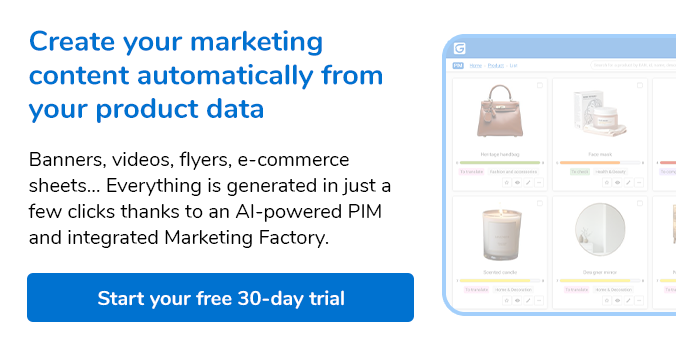In this digital era, businesses are constantly trying to get more and more from their data. To rise to the challenges of process dematerialization, information management solutions are multiplying as rapidly as business data.
Among these solutions, are the PIM (Product Information Management) and DAM (Digital Asset Management), two very different information management solutions working towards a common objective: capitalize on your data to improve product experience management.
While we tend to set them against each other, PIM and DAM are, in fact, perfectly complementary and can work together to improve the first elements of contact for your brand.
. So, what are the characteristics of these two solutions and how can we use them together to improve product experience management? #PIM and DAM, what defines them ?
#What is a DAM?
With the multiplication of digital data in businesses, Digital Asset Management solutions, known as DAM, enable you to manage, organize and distribute digital contents.
From storage databases to collaborative platforms, over the past few years there has been a rise in interest for DAM solutions among sales and marketing teams. Known as a means of managing a large volume of medias, the DAM essentially targets communication agencies, ad agencies and more generally businesses regularly processing multitudes of digital resources: photos, images, video files, sounds and other marketing contents (brochures, flyers, technical fact sheets, pamphlets…).
#What is a PIM?
The PIM (Product Information Management) is a software solution allowing you to centralize, enhance and distribute your product information on all sales channels, and E-commerce websites. Widely used for sales and marketing purposes by retail, consumption and production businesses, the advantage of PIM is to create a unique product reference source, whatever the type of data: logistics, technical, marketing or price related.

In this omnichannel era, the PIM is a solution to the development of consumption methods and helps businesses to build an exceptional product experience through product information that is abundant, targeted and reliable. To avoid the multiplication of computer tools within the company, numerous PIM solutions integrate a DAM directly to centralize all product information within a unique data base.
#Associating PIM and DAM: a competitive advantage?
We often compare the ways in which PIM and DAM are used: PIM focuses on product related information (prices, technical information, marketing descriptions) while DAM is orientated towards the digital media around the product (photos, visuals, logos, graphic elements). In truth, the two are highly complementary and contribute together to the creation of an exceptional product experience. So, what are the advantages for your company in using PIM and DAM together?
#Control the quality of your information
According to a survey by The Shotfarm Product Information Report1, the two contents considered as the most important in the product purchasing process are its description and the accompanying photos. While these two criteria are of the upmost importance in the decision to purchase, generating errors on the information transmitted can have consequences with a huge impact on the consumer's trust in the brand. According to this same survey, over 50% of consumers state that in the event of incorrect product information, they are very unlikely to try that same brand again.
With a PIM and DAM solution, you can update and validate product data as well as the medias provided by the DAM on the company's print and digital materials. The platform also guarantees the reliability and coherency of information and avoids errors in both product descriptions and visuals on all distribution channels.
#Improve your product experience

Moreover, according to a survey carried out by Wavestone on the new consumer trends2, access to highly detailed information on product characteristics arrives in 3rd position (78%) of the web functions that encourage consumers on the Internet. Today, it is essential to provide the consumer with detailed, complete and highly informed product information.
Used correctly, the association of PIM and DAM on a unique platform becomes a real competitive advantage. Thanks to the rights and workflow management system, your teams can enrich your product information collaboratively and centrally: addition of product information (marketing descriptions, technical documents) and medias (images, photos, videos) … a means of simply and efficiently enhancing the first elements of contact with your brand.
To improve your product experience, Goaland is the perfect illustration of a PIM solution intelligently integrating a genuine DAM. To get the most from all of its advanced functionalities, you can either import or store all of your product information in the fully customizable library allowing for detailed indexing of your data or choose to exchange the PIM data directly with the company's DAM.
1(2017, 01). E-commerce: 10 chiffres qui montrent l'importance d'une bonne stratégie de contenu. frenchweb.fr
2(2019, 03). Baromètre des nouvelles tendances de consommation 2019. wavestone.com/fr







